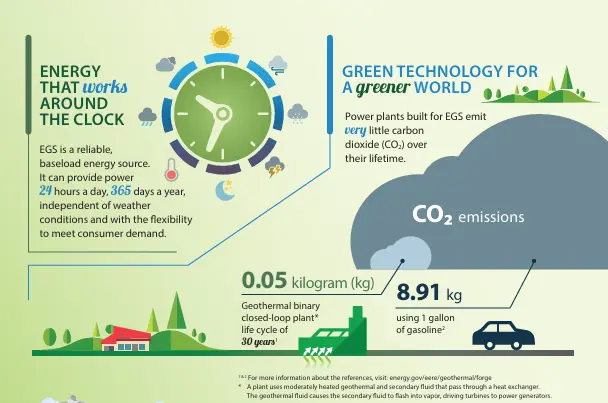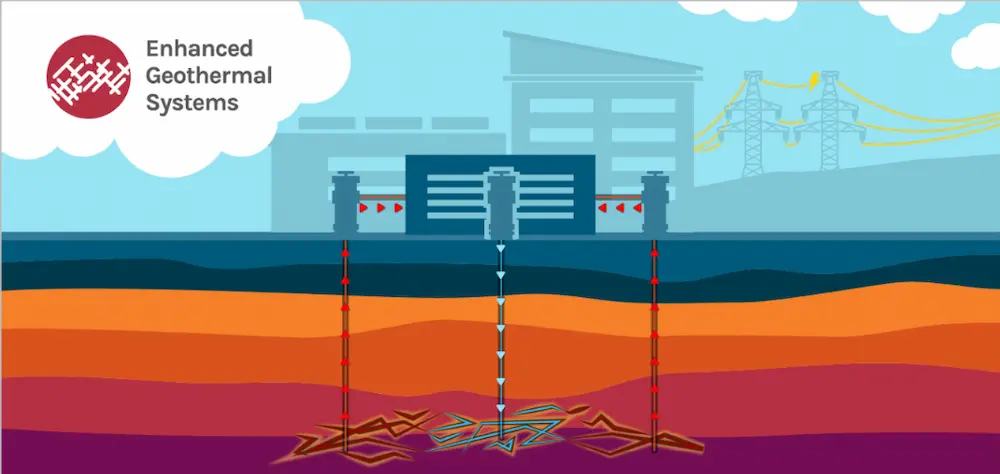The next era of geothermal energy production will likely be shaped by those who have already spent years mastering the underground – the professionals in the oil and gas industries. The rise of clean, renewable energy may be poised to become the rebirth of fossil fuel’s legacy expertise.
What is Geothermal Energy?
Geothermal energy is a renewable energy source that draws on Earth’s internal heat to produce steady, on-demand electricity, a consistency which makes it unique among renewable energy sources. Geothermal energy is unaffected by weather conditions or seasonal fluctuations. And while it currently provides only a small fraction of global energy, new approaches and partnerships could make it a key pillar of tomorrow’s grid.
One surprising catalyst for this shift is oil and gas expertise.

Why Geothermal Matters Now
Geothermal power is not new, but it is newly relevant. Advanced technologies like Enhanced Geothermal Systems (EGS), closed-loop wells, and sedimentary basin applications are expanding geothermal energy’s reach far beyond traditional volcanic zones. These systems can tap heat from deep underground almost anywhere. Geothermal is becoming viable in places like the central U.S., Canada, and Europe where it was once impractical.
According to projections from the International Energy Agency, global geothermal capacity could grow from under 20 gigawatts today to nearly 90 gigawatts by 2050. This would require significant capital, infrastructure, and workforce development. These are areas where fossil fuel firms already have decades of experience.
Bridging Sectors: Oil & Gas Meets Geothermal
Instead of viewing renewables as competition, Energies Media reports that oil and gas companies are finding new purpose by supporting geothermal energy production. This shift does not imply the abrupt end of fossil fuels. Rather, it suggests evolution. Many skills, technologies, and assets from oil and gas are directly applicable to the development of geothermal systems.

Shared strengths between sectors:
- Drilling Expertise: Oil and gas drillers understand complex well design and deep subsurface conditions. These are essential for geothermal expansion
- Reservoir Management: Monitoring fluid flow, temperature, and pressure underground is common to both disciplines
- Infrastructure Assets: Existing wells, pipelines, and data from fossil fuel projects can be repurposed for geothermal use
- Skilled Workforce: Engineers, geologists, and operations specialists can transition quickly from oil and gas to geothermal without needing new degrees
Several companies are already making the leap. Energies Media highlights firms that are working to blend oilfield engineering with geothermal design to create high-performance systems. Their work shows how subsurface knowledge from oil and gas can fast-track geothermal innovation and help cut costs.
Expanding Possibilities Through Technology
Several next-generation geothermal systems are paving the way for broader deployment:
- Enhanced Geothermal Systems (EGS)
These artificially stimulated reservoirs allow access to deep hot rock in areas that lack natural water flows. Techniques like hydraulic fracturing, which are common in shale oil production, are used to create pathways for heat extraction.
- Closed-Loop Systems Instead of drawing water from underground, fluids circulate in sealed loops through boreholes. This prevents water loss and lowers the risk of earthquakes.
- Hot Sedimentary Aquifers
These systems target deep water-bearing rock formations found in sedimentary basins that are familiar to oil and gas regions. Horizontal drilling increases reach and heat capture.

These innovations have major implications. They turn geothermal into a technology that can be deployed virtually anywhere. Potential applications go beyond electricity to include direct heating, industrial uses, and data center cooling.
Regardless of the specific type of system being deployed, it is vital to conduct ecological and environmental surveys of the area, and a comprehensive subsurface utility survey prior to drilling to avoid striking existing buried utilities. GPRS is the only infrastructure visualization company in the U.S. with the ability to locate and map subsurface utilities on a national scale. Plus, our new SiteMap® software platform (patent pending) provides a digital global asset management solution for geothermal, power, and gas & oil, facilities managers to streamline communications, construction, and management of their critical power infrastructure.
Revenue Reimagined
For fossil fuel firms, investing in geothermal is not just about reputation. It is also a smart business move. Revenue streams in this field include:
- Electricity sales from utility-scale geothermal plants
- Thermal energy for heating, manufacturing, or district energy networks
- Technology licensing when companies develop proprietary systems and designs
- Monetizing subsurface data from decades of well logs and seismic surveys
Organizations including major petroleum associations and policy groups are promoting this transition. Presentations like the IOGCC’s 2024 geothermal update encourage producers to view geothermal as a natural extension of their operations. The shared geology and engineering expertise needs make it a logical pivot that aligns with energy diversification and investor expectations.
A Future Built Together
The momentum around renewables does not signal the end of fossil fuel companies. Instead, it presents a turning point. This is a chance to evolve, adapt, and thrive in a changing energy landscape.
Geothermal energy gives oil and gas professionals an opportunity to apply their talents in new ways. They can help solve climate challenges without abandoning their identity. For many firms, this is not a break from tradition. It is a strategic expansion.
GPRS Intelligently Visualizes The Built World® for customers nation-wide.
What can we help you visualize?



.svg)